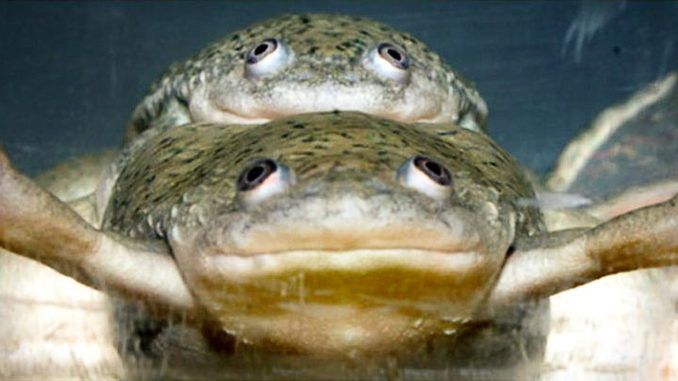
Toxic chemicals found in lakes and ponds are turning males frogs female, according to a surprising new study published in the journal Proceedings of the National Academy of Sciences.
Researchers sampled hundreds of young frogs from 21 ponds in Connecticut and found that estrogenic waste was contributing to the unusually high number of female frogs found in the water.
Newsweek.com reports: The scientists, led by Yale University researcher David Skelly and doctoral student Max Lambert, were surprised to find that the extent of development was strongly linked to the proportion of females; ponds in forests contained lower proportions of females, whereas males were in the minority in some areas of the ‘burbs.

BYPASS THE CENSORS
Sign up to get unfiltered news delivered straight to your inbox.
You can unsubscribe any time. By subscribing you agree to our Terms of Use
Previous work by Skelly’s group found a large percentage of female characteristics in male frogs in these same bodies of water; all 34 ponds examined by Skelly and team turned up males whose testicles also contain eggs. The development of such “intersex” or hermaphroditic traits have been linked to endocrine-disrupting chemicals like the herbicide atrazine. But much of the work in this area has focused on agricultural chemicals. This is one of the first studies to suggest that estrogenic wastes from suburban homes and yards are directly affecting frogs (and perhaps other animals), Skelly says. “This is literally bringing it into our backyards.”
Lambert says that they were surprised to find that estrogenic chemicals from plants may be playing a major part. Compared with forest ponds, he found large quantities of phytoestrogens in suburban water bodies. These chemicals, which can mimic estrogen and affect the sexual development of frogs and other animals (including humans), are produced by plants such as clover and other legumes (soybeans and peanuts, for example). It could be that just by maintaining a lawn and removing native plants from their yards, humans could be impairing the hormonal development of animals. Chemicals that have this effect, like bisphenol A, are called endocrine disruptors.
“This shows that endocrine disruption is a much more diverse phenomenon than we previously realized,” Lambert says.
The study also turned up traces of other estrogenic chemicals called estrones, which are excreted by humans and other animals under normal circumstances. But they didn’t find any trace of synthetic estrogens like those contained in birth control pills.
The endocrine-disrupting chemicals may be coming from lawns and leaking septic and sewer systems, Skelly says, although they haven’t conclusively determined their source.
In the most sexually-skewed suburban pond, the number of female frogs born during the study period was almost double that of males. The scientists also found that in the forests, the number of males actually outnumbered the females, with more than 60 percent of animals born ending up male. That came as a surprise, and raises a number of questions about what a “natural” gender ratio is in these animals, Skelly says.
The study concerned green frogs (Rana clamitans), which are quite common throughout the eastern United States and Canada.
“This is an extremely important study that should make us all think about the collateral damage of suburbanization to natural ecosystems,” says Brad Shaffer, a researcher at UCLA who wasn’t involved in the paper. “Amphibians are very sensitive bioindicators, and this study shows that [suburbanization] has profound impacts on the life history of a common, seemingly resilient species of frog. The observation that the amount of landscaping is having a quantitative effect on the sex determination and population biology of frogs in a nearby pond is amazing.”
One of the strongest arguments that humans are “medicating our environment” and disrupting the development of animals like frogs was put forward more than 20 years ago by scientist Theo Colborn, and discussed at length in her 1996 book Our Stolen Future, Skelly says. She didn’t receive the kind of acclaim that a similarly revolutionary scientist/writer like Rachel Carson did, though, in part because not all of the evidence was there are the time, But studies such as this one are beginning to prove Colborn correct, Skelly adds.


Wonder if that stuff is in the chemtrails.
Important news but old news. This transmutation has been transpiring for decades. Remember the fish in the eastern U.S. rivers?
Just like democrats. Oh the irony…
A world becoming void of males. The final step in Marxism; removing ALL masculinity, maleness and testosterone. Boys will be soy and girls will be 1000x worse than normal. Human, animal or insect.
Where is Alex Jones when you need him?
Oh right…
The estrogen they are putting in our water is removing the testosterone from men and creating genderless men. This estrogen filled water likely ends up in the streams and lakes also, hence the animals and reptiles are also having gender issues. People who lack testosterone don’t resist.
They create genderless men and hyperfemales (being that females also need a small amount of testosterone, and also change with excess estrogen). Not just water, but food. Every lecithin used is soy. Mayonnaise: soy. Dressings, soy. Fry oils: canola and: soy. Etc., etc.
It’s also not just when people were born. There used to be some men, even born up to the 80s and 90s. Now they’re virtually all gone. Likewise, the Boomers did have a lot of men, and most of them are turning into little girls if they haven’t died by now.
Great work my friend!!!